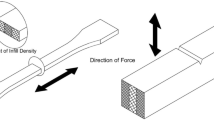Abstract
Additive Manufacturing (AM) has the ability to fabricate complex structures with bio-mimicry features. Fused Deposition Modeling (FDM), which is AM technique, has the capability of creating complex geometry parts in a short time. The mechanical properties of FDM build parts can be improved by selecting the proper printing parameters. In the present study, the effect of printing parameters viz. printing orientation (flat and on-edge) and infill density (20%, 35%, 50%, 65%, 80% and 100%) on the impact strength of bio-inspired 3D printed specimen has been studied. The specimens with multi-infill pattern were inspired by bio-inspired structure like a turtle shell. The multi-infill pattern specimen includes triangular, honeycomb and grid infill patterns. Based on this multi-infill pattern, impact specimens were fabricated and tested. Impact strength and impact strength/weight ratio of specimens in flat and on-edge orientation are measured and evaluated. The result shows that the impact strength and impact strength/weight ratio of multi-infill pattern specimens printed in flat orientation is less compared to specimens printed in on-edge orientation. The multi-infill pattern specimen with 20% infill density printed in on-edge orientation has the highest impact strength and impact strength/weight ratio as compared to other specimens. Further, high magnification fracture surface analysis is performed to aid in the characterisation of specimen failures.













Similar content being viewed by others
Abbreviations
- AM:
-
Additive Manufacturing
- FDM:
-
Fused Deposition Modeling
- PLA:
-
Poly-lactic Acid
- 3DP:
-
Three Dimensional Printing
- SLA:
-
Stereolithography
- LOM:
-
Laminated Object Manufacturing
- SLM:
-
Selective Laser Melting
- SLS:
-
Selective Laser Sintering
- CAD:
-
Computer-Aided Design
- ABS:
-
Acrylonitrile Butadiene Styrene
- ASTM:
-
American Society for Testing and Materials
- HIPS:
-
High Impact Polystyrene
- PET-G:
-
Polyethylene Terephthalate Glycol
- SEM:
-
Scanning Electron Microscopy
References
Govil K, Kumar V, Pandey D P, Praneeth R and Sharma A 2019 Additive Manufacturing and 3D Printing: A Perspective. In: Prasad A, Gupta S, Tyagi R (eds). Advances in Engineering Design. Lecture Notes in Mechanical Engineering. Singapore, Springer, 321–334
Quan Z, Wu A, Keefe M, Qin X, Yu J, Suhr J, Byun J H, Kim B S and Chou T W 2015 Additive manufacturing of multi-directional preforms for composites: opportunities and challenges. Mater. Today. 18: 503–512
Korde J M, Shaikh M and Kandasubramanian B 2018 Bionic prototyping of honeycomb patterned polymer composite and its engineering application. Polym. Plast. Tech. Eng. 57: 1828–1844
Yadav R, Naebe M, Wang X and Kandasubramanian B 2017 Review on 3D prototyping of damage tolerant interdigitating brick arrays of nacre. Ind. Eng. Chem. Res. 56: 10516–10525
Deoray N and Kandasubramanian B 2018 Review on three-dimensionally emulated fiber-embedded lactic acid polymer composites: opportunities in engineering sector. Polym. Plast. Tech. Eng. 57: 860–874
Chua C K and Leong K F 2014 3D Printing and Additive Manufacturing: Principles and Applications. Rapid Prototyping, Fourth Edition. World Scientific Publishing Company
Sin LT, Rahmat A R and Rahman W A 2012 Handbook of Biopolymers and Biodegradable Plastics: Properties, Processing and Applications. Elsevier, Amsterdam
Afrifah K A and Matuana L M 2010 Impact modification of polylactide with a biodegradable ethylene/acrylate copolymer. Macromol. Mater. Eng. 295: 802–811
Lee B H, Abdullah J and Khan Z A 2005 Optimisation of rapid prototyping parameters for production of flexible ABS object. J. Mater. Process. Technol. 169: 54–61
Song Y, Li Y, Song W, Yee K, Lee K Y and Tagarielli V L 2017 Measurements of the mechanical response of unidirectional 3D-printed PLA. Mater. Des. 123: 154–164
Wang L, Gramlich W M and Gardner D J 2017 Improving the impact strength of Poly lactic acid (PLA) in fused layer modeling (FLM). Polymer 114: 242–248
Barner S 2015 Mechanical properties of additive manufactured honeycomb structures. Doctoral dissertation Thesis, Clenson University, Columbia, United States
Sood A K, Ohdar R K and Mahapatra S S 2010 Parametric appraisal of mechanical property of fused deposition modelling processed parts. Mater. Des. 31: 287–295
Ding X F, Jiang L, Liang Y and Wu C W 2011 The structure and mechanical properties of turtle shell and biomimetic. Adv. Mat. Res. 189: 3419–3422
Lalegani D M and Mohd Ariffin M K 2020 The effects of combined infill patterns on mechanical properties in FDM process. Polymers 12: 2792
ASTM D256 2010 Standard Test Methods for Determining the Izod Pendulum Impact Resistance of Plastics, ASTM International, West Conshohocken, PA
Author information
Authors and Affiliations
Corresponding author
Rights and permissions
About this article
Cite this article
Naik, M., Thakur, D.G. Experimental investigation of effect of printing parameters on impact strength of the bio-inspired 3D printed specimen. Sādhanā 46, 151 (2021). https://doi.org/10.1007/s12046-021-01671-8
Received:
Revised:
Accepted:
Published:
DOI: https://doi.org/10.1007/s12046-021-01671-8




